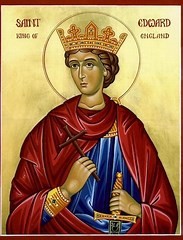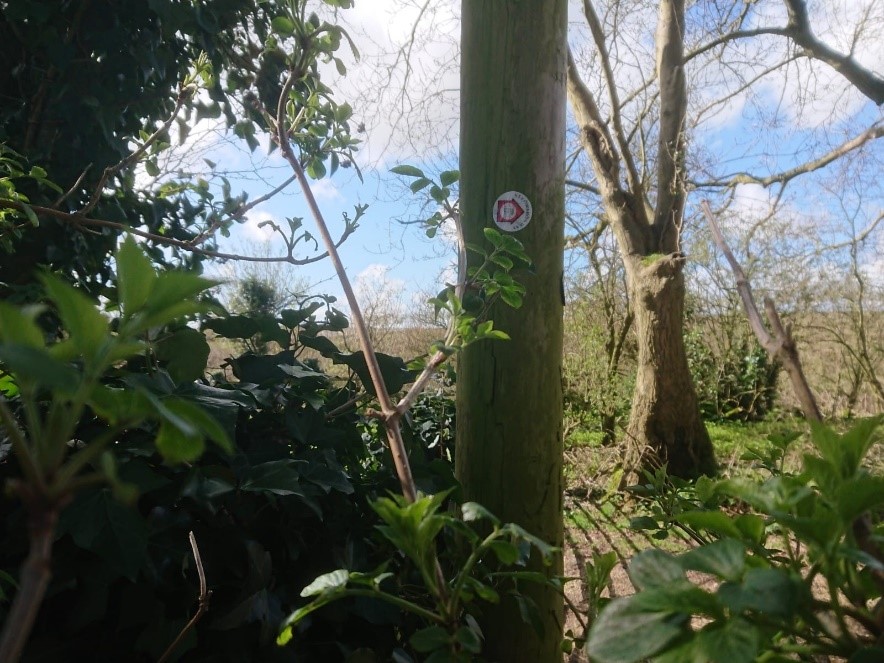'Passion Bearers Then and Now'- Sermon for 29 March 2020
Gospel Reading: John 11: 1 – 45
This weekend I should have been leading a pilgrimage to inaugurate the St Edward’s Way - a waymarked footpath from Wareham to Shaftesbury. I am grateful for all the work that has gone into this, particularly by the local Ramblers who have, in very damp weather, managed to do all the signage. Well, the pilgrimage has been put on hold now as has much of what was normal only about 3 weeks ago.
In anticipating the pilgrimage, it has been interesting to learn a bit more about the life of Edward and how he ended up in Shaftesbury. It’s an interesting tale of the son of King Edgar the Peaceable who succeeded to the throne as King of England in 975 AD. Of his character we learn that he was ‘a young man of great devotion and excellent conduct; he was wholly Catholic, good and of holy life; moreover, above all things he loved God and the Church; he was generous to the poor, a haven to the good, a champion of the Faith of Christ, a vessel full of every virtuous grace’. He was an earnest supporter of the monastics in the life of the Church, as his father had been before him. However this aroused the displeasure of the powerful secular party within the Church, and, as so often happens, that displeasure found allies with ambition and jealousy, and the young king was brutally murdered at Corfe in 979 AD.
 |
The day following his death, the king's body was taken to Wareham and laid to rest there. No sooner was he buried, than miracles began to occur, and we read that: |
"a spring of clear water broke out from beside the grave, and many persons bathed their eyes in it to receive the benefit of restored sight."
On account of the multitude of miracles it was decided to translate the sacred relics to Shaftesbury; this translation and the reburial of the saint with full royal honours took place in 981 AD, incidentally with the then Bishop of Sherborne present!
The story continues. In the year 1001 AD, the sacred relics were again taken up from the grave and placed in an elaborate shrine in the Shaftesbury Abbey church, because, through the miraculous "levitation" of his tomb, the saint had made known that he wished to be exhumed. This "levitation" was in fact the slight raising of the tomb from the ground each day and was witnessed by many. The relics at this time were found to be fragrant, and the bishops gathered there bore witness that they felt that they were standing amid the delights of paradise. So great was the fame of St. Edward that the town of Shaftesbury became known as St. Edward's Borough.
In the sixteenth century, during the reign of Henry VIII, when, at his command, the dissolution of the English monasteries began and so many holy places were demolished, the sacred relics of St. Edward escaped destruction. His bones were hidden, perhaps by the nuns of the abbey, perhaps by Henry's Royal Commissioners themselves, for interestingly only two years before King Henry’s long-awaited heir to the throne, Prince Edward was born. The destruction of the undoubted remains of a saint, martyr and former King of England bearing the same name as the heir, the king's only son, would without doubt have provoked the wrath of the monarch.
Well, that is where most stories end. But not this one! In 1931, the sacred and holy relics were recovered during an archaeological excavation conducted at the ruins of Shaftesbury Abbey and were retained by the man who found them. The bones were later examined by an eminent osteologist, who, at the end of a lengthy report, concludes: "I cannot escape the conviction on historical, anatomical and surgical grounds that, beyond all reasonable doubt, we have here the bones of St. Edward, King and Martyr. The finder of the bones wanted the relics to go to the Russian Orthodox Church outside Russia, whilst his brother wanted them to be returned to Shaftesbury Abbey. So for decades the relics were kept in a cutlery box in a bank vault at the Midland Bank in Woking, Surrey!
In 1979, the appointed Administrator in England of the British Diocese, of the Russian Orthodox Church Outside of Russia, Archimandrite Alexis heard of the holy relics of King Edward and wrote to the man who had discovered the bones who then agreed to give them to the Church to be reverently enshrined. A Synod of Bishops decided to accept without reservations the authenticity of the holy relics and a church which already existed in the Brookwood Cemetery, in Surrey was designated as a holy shrine to Edward the Martyr and has become the final place to for his holy relics.
As well as the interesting, and perhaps amusing and astonishing local story, thinking about Edward on Passion Sunday is quite appropriate. In the Orthodox Church he is known as a ‘Passion Bearer’, someone who accepts death out of love for Christ.
What does it mean to be a 21st century passion bearer? This week we have seen many people make, and maybe have made ourselves, huge sacrifices in helping the population in this time of crisis and confusion. Those working hard in our hospitals to tend the sick; those working long hours trying to fight it with a vaccination. Those working tirelessly in our communities to maintain care, well-being and friendship, albeit through separation and limited resources. Those committed to helping people spiritually maintain lives of faith and prayer. All in their own way acting as passion bearers, selflessly serving.
Our gospel reading today is that of Jesus raising Lazarus from the dead. It is a long gospel and full of description and meaning. It contains both the shortest verse in the Bible. ‘Jesus wept’ a very real reminded of Christ’s humanity, and love for his friends Martha and Mary and their brother, and that great promise that Christ is ‘the resurrection and the life.’ A very real reminder of Christ’s divinity.
Today we stop at the graveyard. Twice in John 11 we are told that Lazarus had been dead for four days. Some commentators say that according to Jewish belief the soul departs from the body after three days. So we are to understand here that Lazarus was really dead. Mary even makes mention of the smell. Do we really want them to roll the stone away?
Yet the passage is all about the power of God to bring life from death and hope from despair. At a basic level the gospel is all about bringing a dead man back to life. John, the gospel writer, believes in miracles and is able to convey to us a sense of what the death meant for those people involved. It was real. Jesus wept; Martha and later Mary affirm that if Jesus had been present Lazarus would not have died; Jesus responds to the distress of Mary and her friends and in the bigger story this encounter will set off a chain of events leading eventually to Jesus’ journey through suffering to glory.
However, something else is going on here. Above the drama at a basic level hovers a higher meaning which comes to expression in Jesus’ response to Martha. Jesus declares ‘I am the resurrection and the life. Anyone believing in me, even if they die, will live and everyone who lives and believes in me will never die.’ At the basic level it is not in fact true, Lazarus will eventually physically die but the point of Jesus’ words is to make us celebrate the claim that people who believe in Jesus Christ find life. Eternal life. Sharing the life of God now and forever.
We see here the power of God who brings hope from despair. As we enter Passiontide this year, we shall all experience in a very real and different way, through our media, our local communities and ourselves the closeness of sickness and death. The mood will undoubtedly be subdued and increasingly serious. When the spirit of excitement, enthusiasm, anticipation, adventure and celebration is gone, what is left? Is there hope?
However, we are reminded that the stone is rolled away. The stench maybe unbearable. Jesus shouts ‘Lazarus! Come out!’ and he does, wrapped in grave clothes. ‘Unbind him!’ says Jesus. They do. New life emerges out of death.
There are many examples of situations in the world where people living with oppression and hardship were also able, by God’s grace, to maintain hope and to work for change. It is a calling to all of us to see where we can bring life from death and hope from despair today.
That is what it means to live as a Passion bearer. Living for others in the sure and certain hope of the resurrection of Jesus Christ. Nothing is so dead that it is beyond the lifegiving reach of Christ’s spirit. St Edward holds for us an example of a holy life cut short, and of one whose death not only testified to the love of Christ in the 10th century, but which now testifies to it through the lives of many Orthodox Christians.
Getting to Easter always requires walking through the graveyard and this year will be harder than most. It’s about how much hope and passion we have on the way that matters. Holding in our minds the Good News of the resurrection will get us there, knowing that God gives us both hope and life.
May God bless you this Sunday.
Document Actions



